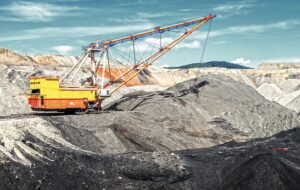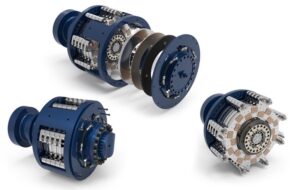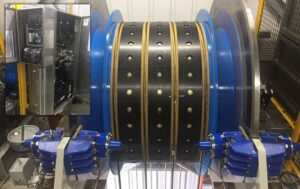GMR Makes the Difference in Australia
Disc brakes were first introduced into the industrial applications environment after being pioneered in production passenger vehicles during the late 50s and early 60s.
When used for vehicle manufacture, disc brakes were seen as a major improvement in safety and performance over traditional braking systems.
Companies like Twiflex embraced the new disc brake systems from their earliest introduction and have continued to develop the technology for industrial purposes.
Traditionally, walking dragline excavators have employed band and drum brake technology to achieve static braking on the machine.
Unfortunately, these traditional braking systems have some inherent reliability problems such as poor maintainability characteristics, low efficiency levels and high maintenance costs. Many of these problems are due to the fact that the brakes are often used dynamically rather than the intended use as a parking brake.
New research and development has led to the adaption of modern caliper-type disc brakes into dragline machinery.
One such unit has been successfully trialled at the Bowen Basin in Queensland, and has been followed by other installations in various draglines in the region.
The adaptation of disc brakes on dragline equipment generates a number of advantages over existing braking systems.
The new technology leads to increased operational safety margins; increased brake efficiency and reliability; significantly decreased maintenance costs; and improved dynamic braking capability.
Using increased efficiency and increased capacity to dissipate heat, disc brakes offer much improved service characteristics over any other brake type. Some of the secondary beneficial effects that arise from the use of disc brakes include: a reduction in machine inertia; reduced overhung loads on electric motors (thus improving bearing performance); considerable space savings and weight reductions; reduced structural stresses and stress concentration points; and a reduction of motor power requirements.
Mechanisms
One characteristic of the disc brake is its compact construction.
The entire brake system consists only of the disc, brake and thrusters.
Compare this with a drum brake comprising a drum, brake shoes, pivot arms, thruster and spring. In addition, the thruster used in drum brakes is a piston type cylinder that has a long stroke and, therefore, a longer reaction time.
In the disc brake, the thruster is diaphragm-operated requiring little space, very small strokes, very little air and half the air pressure to operate. Moreover, the pads act parallel to the disc surface two benefits: consistent torque capacity throughout the pad life, and a linearly increasing braking torque as the applied gripping force of the caliper rises. This allows for much improved control of braking torque. In drum brakes, the braking torque can increase sharply with the applied pad pressure and can lead to sudden brake lock-up – even with grip forces that are under those required to achieve full braking torque.
Furthermore, in drum brakes, the braking effect will fade with time and repeated brake applications. With disc brakes, the braking effect is maintained virtually unchanged with repeated applications and prolonged braking times. This is due to the disks higher thermal efficiency. In general, a well designed disc brake should be able to operate at least 150 times per hour without experiencing any fade.
Multi-disc friction brakes
A commonly used brake type in larger dragline equipment is the multiple disc friction brake. This consists of two or three rotating discs mounted in an alternating pattern with stationary annular friction pads.
In this type of brake, the total braking surface area of the disc is covered by the annular friction pad. Unfortunately, this tends to make this type of brake thermally inefficient under dynamic conditions, as it is unable to dissipate heat effectively.
As a parking brake, however, this type of brake suits its purpose well. Nonetheless, in practical operation of the machine, dynamic braking is often used and this type of brake is characterised by high wear rates under these conditions. In addition, this type of brake allows for just a single adjustment to be performed through the life of one set of friction pads.
Following this, a complete re-build of the brake is required – which can be a costly exercise.
Disc brakes in draglines
The use of disc brakes in draglines isn’t new.
A caliper-type disc brake was installed on a dragline drag machinery motor in 1997 at Peak Downs Mine. Since then, this particular brake has operated without any adjustment or major maintenance.
A single set of friction pads was removed from the brakes earlier this year, but only due to accidental damage rather than operational wear. This means that the disc assembly has operated for a period of five years without any maintenance being required – not even a friction pad change or brake adjustment.
Newer systems are even more compact and advanced. The performance characteristics are, however, very similar.
Some benefits include:
- The entire brake system can be mounted to the back of the motor with no need for any floor welding or mounts
- The safety guards allow the thruster assemblies to be exposed easing maintenance. The thrusters also have their own removable cover, for ease of inspection.
- The system is much more compact and light-weight and can be manually handled with no need for additional lifting equipment – other than for initial mounting of discs and hubs.
- The newer system also employs the use of diaphragm type thrusters, which are more compact and have the spring assembly built into the enclosure. This reduces the amount of components in the system.
Lower running costs
As with any major dragline project, there are considerable costs involved in making significant changes to the mechanical make-up of the machine.
However, the running costs are much lower.
First, the price of the replacement pads is much lower than a shoe and they last longer. Second, the cost of manufacturing a flat disc from mild steel is less than manufacturing a cast drum.
The disc is also attached to a hub using bolts and can be removed from the motor without removing the calipers.
Third, the thrusters are significantly more reliable.
Being of a diaphragm type, the disc brake thruster requires no ongoing maintenance. The thruster casing is made from alloy material and is not subject to the same environmental deterioration as steel.
The brake spring is built into the thruster assembly and does not occupy any extra space. Rebuilding a thruster can be performed quickly and economically by simply replacing the rubber diaphragms, seals and spring pack.
Similarly, the friction pads are only a fraction of the cost of the existing drum shoes.
In short, the required planning and maintenance effort required with disc brakes is considerably smaller than that required for drum or multiple disc brakes. Subsequently, running costs are much lower.
The expected life span of friction pads on the proposed disc brake assemblies would be significantly higher than that in drum shoes and replacement would not need to be performed as often.
Preliminary calculations indicate that pad life may in fact be directly proportional to shutdown intervals.
Capital investments
The costs associated with ongoing brake maintenance form a major portion of general dragline running costs.
As with any other significant engineering project, a one-off capital investment would be required for the total modification of a dragline from the existing braking system to the proposed disc brakes.
However, the cost impact can be softened by performing any changes in planned stages by the maintenance or machine group.
In terms of capital investment, the cost of a single disc brake assembly for a Dragline application can be in the $30,000 range – the cost being determined by the motor frame size and power. When compared to the cost of a new drum brake or multiple disc brake assembly, it is significantly more economical. When considering that the running costs of the disc brakes are virtually negligible, the payback period would be expected to be very short. And the manpower, time and effort required for maintenance is significantly lower.
For a standard Indresco-Marion 8050 dragline or Bucyrus-Erie 1370 dragline, for example, the total cost of upgrade for the hoist, drag and swing machinery is of the order of $360,000.
For larger machines, such as an Indresco-Marion 8200 Dragline, this cost is inevitably higher.
Reduced maintenance
Motion Industries fitted three sets of Twiflex Disc Brakes to the hoist motors on DL6 at Anglo Coal Moura Mine in August 2003, and another six sets on Dl5 at the same site in November 2003.
So far there has been no maintenance carried out on any of these sets, and there has been an improvement in braking performance. In addition, there has been a reduction in motor vibration, compared to the previous multi-disc arrangement.
The company has also supplied a set for a Marion Shovel at Xstrata Coal and this has also proved to be a success.
Motion Industries has orders for another eight sets for a BE1370 machine, three sets for an 8750 Marion and an enquiry for a full set of hoist, drag and swing brakes for a Marion 8050 and a hoist brake for a P+H shovel.
Article first published in TecTorque November 2004.




